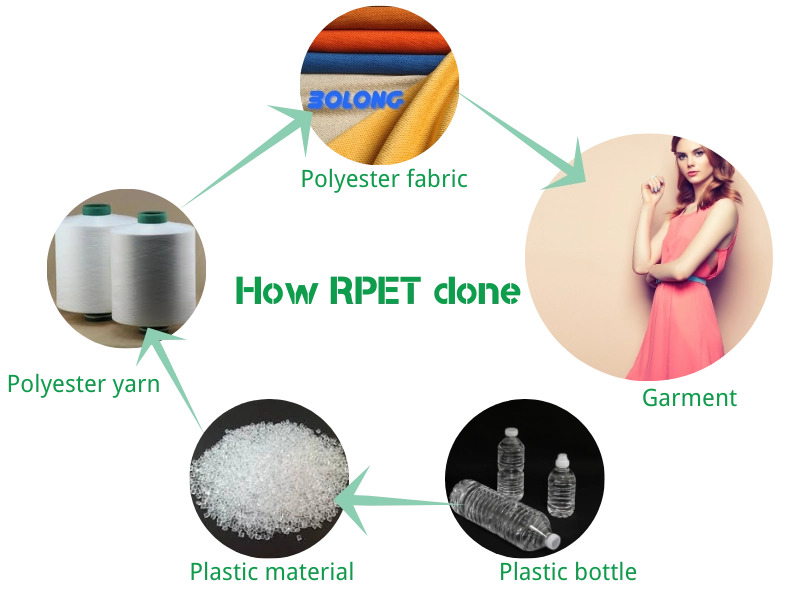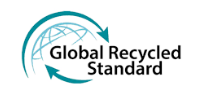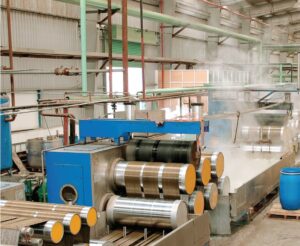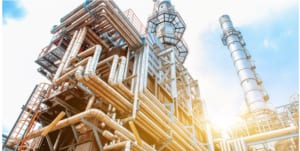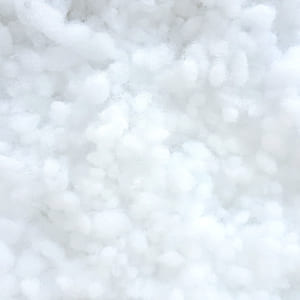What is recycled polyester fabric?
Recycled fabric is the fabric that it is made from recycled materials to refine a new valuable item. The garbage or wastage we dumped into the trash every day can be recycled, reused, and re-created. Therefore, trashes like clothing waste, food waste (such as fish scales) and plastic bottles are major types of materials that can be reused by using simple technological processes to produce recycled fabrics.
What are recycled polyester fiber?
Recycled polyester staple fiber refers to the use of polyester fabric, waste polyester bottle flakes, spinning waste, foam material, pulp block as raw materials, waste bottle flakes are crushed and cleaned, and the mixture of various materials is dried, melted and extruded.
RPET material is made 100% from plastic bottles and its composition is Polyester, so we can also call ”RPET” equal to “Recycled Polyester”.
Advantages
- The use of recycled polyester can effectively reduce the amount of petroleum The data shows that each ton of recycled polyester yarn can save 1 ton of oil and 6 tons of water.
- It can reduce CO₂ emissions, recycle and reuse resources, and reduce environmental Recycling a 1-liter plastic bottle can reduce CO ₂ emissions by 0.042 kgs, and for every 20 plastic bottles recycled, which can be processed into a summer T-shirt.
Recycled polyester fabric, also known as rPET, is a synthetic material made from plastic waste that is recycled from PET bottles, bags, containers, etc. It is eco-friendly, affordable, and durable, with the same properties as virgin polyester. It has many applications in clothing, especially for activewear and sports apparel, as well as in industrial products such as car tires, ropes, and conveyer belts. Recycled polyester fabric reduces the environmental impact of plastic pollution and saves energy and water compared to virgin polyester production
Everyday millions of plastic bottles are being thrown away , meanwhile those bottles can be ecofriendly and sustainable resource. By choosing recycled PET polyester fabric & yarn , we’re able to help plastic bottles out of the landfill and oceans . recycled PET yarn can performance as well as regular virgin yarn with much smaller footprint .
RPET requires 86% less water than regular virgin polyester.
RPET consumes 70% less energy than regular virgin polyester.
RPET produces 75% less co2 emission than regular virgin polyester.
What is the difference between polyester fabric and recycled polyester fabric?
Unlike traditional polyester made from petroleum and coal, recycled polyester gets a second life from waste plastic bottles. This not only saves resources but also keeps plastic out of landfills. And the good news? Recycled polyester offers the same fire resistance, comfort, and style as its virgin counterpart, even boasting antibacterial and antiviral properties!
Now, let’s compare. Regular polyester relies on fossil fuels, harming the environment. In contrast, recycled polyester gives plastic a new purpose, reducing our dependence on non-renewable resources. Plus, it retains the awesome qualities of polyester we all know and love, like stain resistance, quick drying, and wrinkle-free wear.
The recycled polyester fabric is the future
More and more companies are choosing it for their products, recognizing its eco-friendly benefits. It’s our responsibility to protect the planet, and using recycled polyester is a great step in the right direction. Let’s all do our part and embrace the power of recycled clothing!
We supply recycled polyester fabric or eco-friendly fabric, which includes fabric items with Global Recycling Standard (GRS) certified. It is proved that using recycled polyester helps to reduce energy, air pollution, water pollution and waste if compare to virgin polyester fabric made from petroleum.
Is recycled fabric safe ?
Recycled fabrics are a safe alternative to regular polyester and polyester blends ! Our products are tested and certified by GRS (Global Recycled Standard) in every step of production chain ,we provide full transparency and traceability.
How can we produce RPET yarn & recycled fabric ?
- We collect recycled plastic bottles from Chinese mainland and oceans . when these bottles reaching our factory , we are starting to turn waste into fabric
- A flotation and separation process remove bottle’s caps and lables , as these caps and labels are different characteristics plastic . then we’ll crush bottles into tiny flakes.
- Tiny flakes will be washed and sifted so as to be melted and polymerized.
- Cut into chips and stable fibers.
- Chips & stable fibers can be spun into yarns , yarns will be woven or knitted into various recycled PET fabrics
- A Plastic bottle weighs about 20g/27g/24g, now we can take 24g bottle for example,24g*71%(about 71%of a plastic bottle can be made into fabric )≈17.04g(a plastic bottle weighs in full width fabric ).
- The fabrics you buy weigh 110gsm and greige fabrics full width 1.52m,So 1 meter fabrics may equal to 110gsm*1.52m/17.04g≈9.8 plastic bottles.

